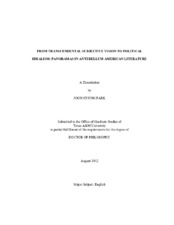| dc.description.abstract | This dissertation explores the importance of the panorama for American Renaissance writers' participation in ideological formations in the antebellum period. I analyze how Ralph Waldo Emerson, Henry David Thoreau, Nathaniel Hawthorne, William Wells Brown, Henry Box Brown, and Harriet Beecher Stowe use the panorama as a metaphorical site to contest their different positions on epistemological and sociopolitical agendas such as transcendentalism, masculinist expansionism, and radical abolitionism.
Emerson uses the panorama as a key metaphor to underpin his transcendental idealism and situate it in contemporary debates on vision, gender, and race. Connecting the panorama with optical theories on light and color, Emerson appropriates them to theorize his transcendental optics and makes a hierarchical distinction between light/transparency/panorama as metaphors for spirit, masculinity, and race-neutral man versus color/opacity/myopic vision for body, femininity, and racial-colored skin. In his paean to the moving panorama, Thoreau expresses his desire for Emersonian correspondence between nature and the spirit through transcendental panoramic vision. However, Thoreau's esteem for nature's materiality causes his panoramic vision to be corporeal and empirical in its deviation from the decorporealized vision in Emerson?s notion of transparent eyeball. Hawthorne repudiates the Transcendentalists' and social reformers' totalizing and absolutist idealism through his critique of the panorama and the emphasis on opacity and ambiguity of the human mind and vision. Hawthorne reveals how the panorama satisfies the desire for visual and physical control over the rapidly expanding world and the fantasy of access to truth. Countering the dominant convention of the Mississippi panorama that objectifies slaves as a spectacle for romantic tourism, Box Brown and Wells Brown open up a new American subgenre of the moving panorama, the anti-slavery panorama. They reconstruct black masculinity by verbally and visually representing real-life stories of some male fugitive slaves and idealizing them as masculine heroes of the anti-slavery movement. In Uncle Tom's Cabin, Stowe criticizes how the favorable representation of slavery and the objectification of slaves in the Mississippi panorama and the picturesque help to construct her northern readers' uncompassionate and hard-hearted attitudes toward the cruel realities of slavery and presents Tom's sympathetic and humanized "eyes" as an alternative vision. | en |


